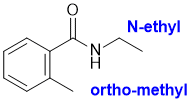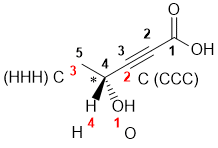All the bonds indicated are sp3 CH bonds but they are primary, secondary and tertiary (number of C attached to the involved C atom) and in different proximity to an alkene (i.e. allylic). Being adjacent to the alkene weakens the C-H bonds, so the strongest bond here is the tertiary C-H. When comparing the other two, both are allylic, so the primary allylic is stronger than the secondary allylic. (v1= E, v2 = B)

Boiling points are controlled by intermolecular forces. The biphenyl is a much larger molecule with lots of surfaces in contact (it's a solid at room temperature) and will have a high boiling point. The two other molecules are a lot smaller. The alcohol will have H-bonding in the liquid so it will have a higher boiling point than the aldehyde (no H to donate to an H-bond). (v1= A, v2 = C)

Acidity...the structures are an amine NH, CH adjacent to a carbonyl in a ketone and a CH of a terminal alkyne.
The CH adjacent to the C=O in the ketone is made more acidic because the H are adjacent to the C=O so they give a conjugate base where the anion is resonance delocalised to allow the negative charge on to the electronegative oxygen atom (pKa ketone alpha-CH about 20). In the amine, the conjugate base will have -ve charge on an electronegative N atom, some resonance delocalisation to the adjacent aromatic system (pKa about 27 for aniline). Terminal alkynes can be deprotonated to give a stabilised sp carbanion (pKa = 25). So, in terms of acidity ketone > terminal alkyne > aniline (v1= D, v2= C)

Qu 4:

Ranking resonance structures...we need to check for complete octets and maximised bonding (within the octet rule limitations) and for charge separation in accord with electronegativity. (v1= AB, v2= C)

Assign the formal charges...N with 2 bonds and 2 lone pairs is -1, Cl with 2 bonds and 2 lone pairs is +1. A O atom with 1 bond, 2 lone pairs and a single e is 0 (v1= D, v2=D)
Each different monochlorination product comes from a different type of H, so how many different types of H are there ? Counting types of H (models lab). Consider the position and symmetry (v1= AB, v2= E)


MOLECULAR PROPERTIES:
No real method here, really just do you know various aspects of molecular structure and apply it to the molecule(s) in question.
Basicity...Think about the availability of the electrons in the bases, always a good idea to draw in the lone pairs because lone pairs are more available than bonded pairs. We have N, O and F systems. In terms of electronegativity F > O > N so N will tend to be more basic. The simple amine (N12) where the N is sp3 hybridised will be more basic than the sp2 N (N19)... think about the impact the nature of the orbital has on the energy of the electrons of the N lone pairs. (v1= E, v2= D)
N16 is part of an amide where the N is part of pi system (resonance) so the N must be sp2 hybridised with the lone pair in a p orbital. N23 is also part of pi system (resonance) so the N must be sp2 hybridised with the lone pair in a p orbital. (v1= A, v2 = E)
N19 is involved directly in one double bond so the N must be sp2 hybridised with the lone pair in a hybrid sp2 orbital. (v1= D, v2 = C)
SPECTROSCOPY:
Use the IR spectra provided to get the functional groups that are present in the structures, so look for the key groups : C=O (near 1700 cm-1) , -OH or -NH (above 3000 cm-1), aromatic C=C (two bands 1600-1400 cm-1), C-O (near 1200 cm-1) and triple bonds (near 2200 cm-1).... use the tables as needed.

The IR shows a C=O near 1675 cm-1 (which would be low for a simple ketone), and two bands above 3200 cm-1 which tends to indicate an -NH2. Together these observations imply the amide. (v1= AC, v2= CD)

The IR shows a C=O a little above 1700 cm-1 (normal for a ketone). The IR does not show -OH or -NH, or C=C, or triple bonds, and no real sign of C-O. On closer inspection, the C-H stretches are < 3000 cm-1 indicating sp3 C-H only. This would be consistent with the ketone. (v1= AD, v2= D)

The IR shows a strong C=O near 1800 cm-1 (which would be very high for a simple ketone), no -OH above 3000 cm-1. This would be consistent with acyl chloride. (v1= CD, v2= E)


NOMENCLATURE:
Two types of questions here, however it is a good idea to use key descriptors like E and Z, R or S, cis or trans, numbering, functional group etc. to help screen the answers before getting too tied up in the words. For the first four, name the compound and then match it to the list, for the last four
use the key descriptors and check each molecule in turn. So this section really depends on the nomenclature rules.
A substituted cyclohexene. Need to number to make the alkene C1 & C2. In this case, the first point of difference rule dictates needing to give the two methyl groups the lower number and then need to list the substituents alphabetically (ethyl before methyl) ignoring the di prefix. Hence 5-ethyl-4,4-dimethylcyclohexene. (v1= D, v2= A)

The longest chain including the principal functional group (a ketone) is C5, so we have a pentanone system. The C=O is at C3, with a methyl group at C2. The molecule does not have a chirality center. Therefore we have 2-methylpentan-3-one (v1= AB, v2= E)



Naming of simple alkyl groups : here we save an isobutyl and a tert-butyl within an ether (v1= D, v2= C)

Substituted benzenes and amide naming. The C=O (acid) side of the amide is based on benzoic acid. The ortho methyl group needs to be on the ArC next to where the C=O is and then an ethyl group on the amide N (v1= C, v2=E)

R/S stereochemistry
Chirality center is marked with a *. Priority of groups there is O > C(C, CCC) > C(C,HHH) > H. Also need to remember to view from the back so that the low priority group is away when assigning R or S. (v1= B, v2= D)

The bicyclic system needs to have 5C (pent) and an alkene since it is a pentene. The [2.1.0] indicates the number of C atoms in each link between the central C atom. Need to start to number from the bridgehead C then round the larger ring first. (v1= B, v2= C)
